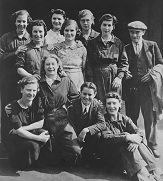|
Women at War Survival |
|||||||
In February 1942 the already severe staff shortages were made more acute when it was announced that the call-up would immediately be extended to all single women in the twenty to twenty-one age group. The general managers responded to this development in a memorandum sent to all district supervisors;
it is up to us to find a prior substitute ... if we wish to avoid the possibility of the Ministry of Labour getting tired of our refusing the often unsatisfactory substitutes they send and taking away the employee without prior substitute A third recruitment drive was therefore undertaken which paralleled that of the first weeks of the war, with the new recruits working alongside those they were to replace. This completed the transition from a work-force composed of mainly young unmarried men to one of a part-time married women, older men and young people under the age of eighteen.
Special care was taken by Sainsbury's to retain its female employees. It was recognised that working women were frequently juggling the demands of their work with looking after a family. New staff were given 'mentors' to help them settle into the job while managers were instructed to take a personal interest in their training. Every member of the staff was paid personally by the manager so that problems could be discussed in private. The hardships and anxieties caused by wartime conditions were also appreciated by Sainsbury's who told managers to be understanding about the effects of lost sleep during bombing raids, damage to employees' homes and particularly to bereavement. The general managers asked to be informed: we think the least we can do is to express the sympathy of the firm in their anxiety or sorrow. It was realised that women who had families and worked full-time might have difficulty in finding time to do their shopping. A discretionary 'shopping time' allowance of one hour a fortnight was therefore granted in 1943 and became a right for all female staff over the age of eighteen in April 1944. During the flying bomb raids, when many schools were closed, married women were even permitted to bring their children to work. Women were given permission in October 1941 to dispense with wearing stockings, which were by then very scarce and precious. During a cold snap in November 1943 they were allowed to wear 'slacks' and 'woolies' under their overalls and to wear warm bootees instead of shoes.
|
